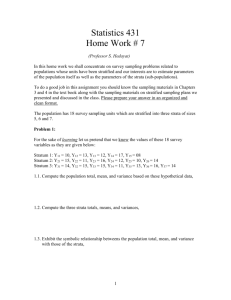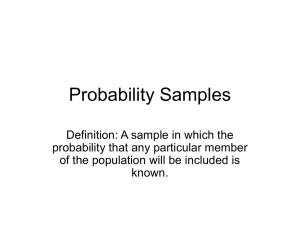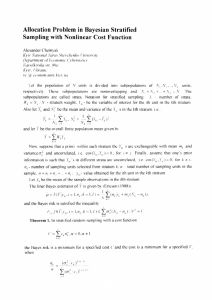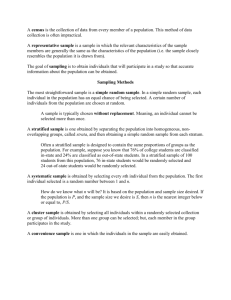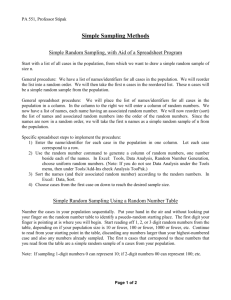3.5
advertisement
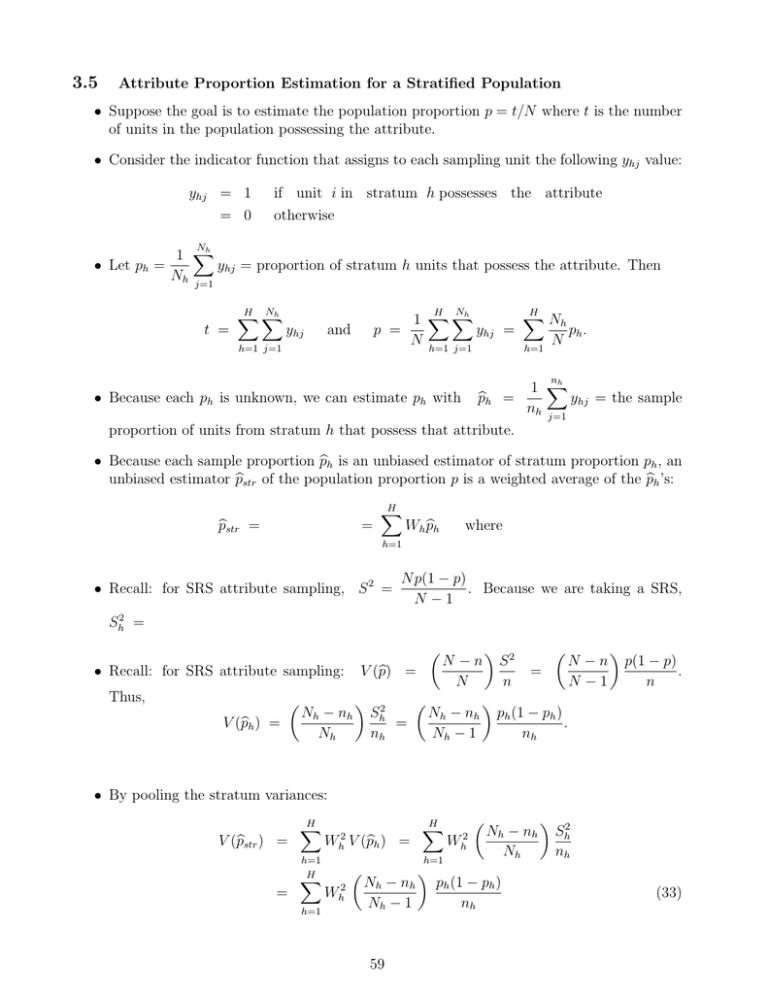
3.5 Attribute Proportion Estimation for a Stratified Population • Suppose the goal is to estimate the population proportion p = t/N where t is the number of units in the population possessing the attribute. • Consider the indicator function that assigns to each sampling unit the following yhj value: yhj = 1 = 0 if unit i in stratum h possesses the attribute otherwise Nh 1 X • Let ph = yhj = proportion of stratum h units that possess the attribute. Then Nh j=1 t = Nh H X X yhj H H Nh X 1 XX Nh p = yhj = ph . N h=1 j=1 N h=1 and h=1 j=1 nh 1 X • Because each ph is unknown, we can estimate ph with pbh = yhj = the sample nh j=1 proportion of units from stratum h that possess that attribute. • Because each sample proportion pbh is an unbiased estimator of stratum proportion ph , an unbiased estimator pbstr of the population proportion p is a weighted average of the pbh ’s: pbstr = = H X Wh pbh where h=1 • Recall: for SRS attribute sampling, S 2 = N p(1 − p) . Because we are taking a SRS, N −1 Sh2 = N − n S2 N − n p(1 − p) = . • Recall: for SRS attribute sampling: V (b p) = N n N −1 n Thus, Nh − nh ph (1 − ph ) Nh − nh Sh2 = . V (b ph ) = Nh nh Nh − 1 nh • By pooling the stratum variances: V (b pstr ) = H X Wh2 V (b ph ) = h=1 = H X h=1 H X h=1 Wh2 Nh − nh Nh − 1 59 Wh2 Nh − nh Nh ph (1 − ph ) nh Sh2 nh (33) • Recall: for SRS attribute sampling: s2 = nb p(1 − pb) . Thus, s2h = n−1 • Because Sh2 is unknown, we use s2h to get the unbiased estimator of the variance in (33): 2 H H X X N − n s pbh (1 − pbh ) N − n n h h h h 2 2 Vb (b pstr ) = Wh = (34) Wh N n N n h h h h−1 h=1 h=1 • To generate a confidence interval for p, calculate q pbstr ± t∗ Vb (b pstr ) (35) where t∗ is the upper α/2 critical value from the t(d) distribution. In this case, d is Satterthwaite’s approximate degrees of freedom d (see equation (32)). • For larger sample sizes, some people use z ∗ instead of t∗ . • Sample Size Determination: You can use the same sample size formulas defined earlier for estimating y U for a stratified SRS. Stratification Example using Longleaf Pine Data Data • This 200 × 200 m study region is located in an old-growth forest in Thomas County, Georgia, USA. The region has been divided into a 20 × 20 grid of 10 m ×10 m quadrats. This data represents the presence=1 or absence=0 (Table 6) of longleaf pine trees located in each quadrat. The population proportion p = 249/400 = 0.6225. • The longleaf pine census data will be stratified into four 10 × 10 strata. The stratum sample sizes are nh = 10 for h = 1, 2, 3, 4. The values in parentheses are the sampled quadrats. Figure 6: The Presence or Absence of Longleaf Pine 1 1 1 1 (1) 1 1 (0) 0 0 (1) 1 0 1 0 1 1 1 1 1 1 0 1 0 0 0 1 1 1 1 0 1 1 1 0 1 1 1 1 1 1 1 0 (0) 0 1 1 0 1 1 1 1 1 1 0 1 1 0 0 0 (0) (0) (1) 1 1 1 1 (0) 0 0 1 1 1 1 0 1 1 1 0 0 1 1 1 1 1 1 1 1 1 1 1 0 0 0 1 1 1 (0) 1 1 1 0 1 1 1 0 0 1 0 0 (1) 1 1 1 1 1 0 1 0 1 0 (1) 1 0 1 (1) 0 0 1 1 1 1 1 1 1 1 0 1 0 0 1 1 1 0 0 0 1 1 1 1 1 1 1 1 1 1 (0) 0 1 1 0 1 0 0 (0) 0 1 0 1 1 1 (1) 1 0 1 0 1 0 (1) 1 1 1 1 1 1 0 1 0 1 0 1 1 0 0 1 1 1 1 0 1 1 0 (0) 1 (1) 1 (0) 0 0 1 1 1 0 1 1 1 0 0 0 1 0 1 1 1 1 1 1 0 0 1 1 1 1 0 0 1 (0) 0 1 (1) 0 1 1 1 1 0 0 (1) 1 1 1 0 1 0 0 1 1 0 (0) 0 (1) 1 1 1 1 1 0 0 1 0 0 (1) 0 1 1 0 1 1 0 1 0 0 1 0 0 1 1 1 0 0 0 1 1 1 0 0 0 0 0 1 1 (0) 1 1 1 (1) 1 0 0 1 0 1 0 1 0 0 1 1 1 0 0 0 (1) 1 0 0 0 0 0 0 (0) 1 1 1 0 1 0 1 0 (1) 0 1 1 0 0 0 0 0 0 (0) 1 1 0 (1) 1 0 0 1 0 1 60 0 1 0 1 1 (1) 1 0 1 1 1 (1) (1) 0 1 1 1 0 (1) 0 (1) 1 1 1 1 1 (1) 1 (0) 0 1 (1) 1 1 1 0 1 0 1 1 3.5.1 Using R and SAS to Analyze a Stratified SRS for a Proportion R Code to Analyze a Stratified SRS for a Proportion source("c:/courses/st446/rcode/confintt.r") # t-based confidence intervals for SRS in Figure 6 library(survey) pa <- c(rep(0,6),rep(1,4),rep(0,6),rep(1,4), rep(0,2),rep(1,8),rep(0,2),rep(1,8)) stratum <- c(rep(1,10),rep(2,10),rep(3,10),rep(4,10)) fpc <- c(rep(100,10),rep(100,10),rep(100,10),rep(100,10)) strat6dat <- data.frame(pa,fpc,stratum) strat6dat strat_design <- svydesign(id=~1, fpc=~fpc, strata=~stratum, data=strat6dat) strat_design estp <- svymean(~pa,strat_design) print(estp,digits=15) confint.t(estp,degf(strat_design),level=.95) confint.t(estp,degf(strat_design),level=.95,tails=’lower’) confint.t(estp,degf(strat_design),level=.95,tails=’upper’) R Output 1 2 3 4 5 6 7 8 9 10 11 12 13 14 15 16 17 18 19 20 pa 0 0 0 0 0 0 1 1 1 1 0 0 0 0 0 0 1 1 1 1 fpc stratum 100 1 100 1 100 1 100 1 100 1 100 1 100 1 100 1 100 1 100 1 100 2 100 2 100 2 100 2 100 2 100 2 100 2 100 2 100 2 100 2 21 22 23 24 25 26 27 28 29 30 31 32 33 34 35 36 37 38 39 40 0 0 1 1 1 1 1 1 1 1 0 0 1 1 1 1 1 1 1 1 100 100 100 100 100 100 100 100 100 100 100 100 100 100 100 100 100 100 100 100 3 3 3 3 3 3 3 3 3 3 4 4 4 4 4 4 4 4 4 4 Stratified Independent Sampling design ------------------------------------------------------------------mean( pa ) = 0.60000 SE( pa ) = 0.07071 Two-Tailed CI for pa where alpha = 0.05 with 36 df 2.5 % 97.5 % 0.45659 0.74341 ------------------------------------------------------------------61 ------------------------------------------------------------------mean( pa ) = 0.60000 SE( pa ) = 0.07071 One-Tailed (Lower) CI for pa where alpha = 0.05 with 36 df 5 % upper 0.48062 infinity ------------------------------------------------------------------------------------------------------------------------------------mean( pa ) = 0.60000 SE( pa ) = 0.07071 One-Tailed (upper) CI for pa where alpha = 0.05 with 36 df lower 95 % -infinity 0.71938 ------------------------------------------------------------------SAS Code to Analyze a Stratified SRS for a Proportion data fig5c; do Area = 1 to 4; do i = 1 to 10; input ind @@; output; end; end; datalines; 1 0 1 0 0 0 0 0 1 1 1 0 0 1 1 0 0 0 0 1 1 0 0 1 1 1 1 1 1 1 1 1 0 1 1 1 1 1 0 1 ; data fig5c; set fig5c; if if if if Area Area Area Area = = = = if if if if Area=1 Area=2 Area=3 Area=4 1 2 3 4 then then then then then then then then W W W W _total_= _total_= _total_= _total_= = = = = 100; 100; 100; 100; 100/10; 100/10; 100/10; 100/10; *** _total_ = Nh ; *** W = Nh / nh ; if ind = 0 then pa = ’absent ’; if ind = 1 then pa = ’present’; title1 ’Analysis of Stratified SRS in Figure 5c’; title2 ’Estimate Proportion p of Quadrats with Presence of Trees’; proc surveymeans data=fig5c total=fig5c mean clm df; stratum Area / list; var pa; weight W; run; 62 Analysis of Stratified SRS in Figure 6 Estimate Proportion p of Quadrats with Presence of Trees The SURVEYMEANS Procedure Data Summary Number of Strata Number of Observations Sum of Weights 4 40 400 Class Level Information Class Variable pa Levels 2 Values absent present Stratum Information Stratum Population Sampling Index Area Total Rate N Obs Variable Level N -----------------------------------------------------------------------1 1 100 10.0% 10 pa absent 6 present 4 2 2 100 10.0% 10 pa absent 6 present 4 3 3 100 10.0% 10 pa absent 2 present 8 4 4 100 10.0% 10 pa absent 2 present 8 -----------------------------------------------------------------------Statistics Std Error Variable Level DF Mean of Mean 95% CL for Mean -----------------------------------------------------------------------pa absent 36 0.400000 0.070711 0.25659210 0.54340790 present 36 0.600000 0.070711 0.45659210 0.74340790 ------------------------------------------------------------------------ 3.6 Quota Sampling • When the population is stratified based on more than one factor we are using multifactor stratification. Typically, a sample is taken within every combination of strata across the factors. – A marketing survey was conducted to get information on computer users’ use of the internet for shopping. The surveyor suspected there may be differences based on gender (2 levels), household income (6 levels), and age (5 levels). There would be 2 × 6 × 5 = 60 multifactor strata to sample from. • Quota sampling is a form of stratified sampling and typically uses multifactor stratification. Taking a quota sample ensures that data are collected across the population with the belief that doing so will provide a representative sample from the population. It also allows the researcher to generate estimates related to various subgroups. 63 • So how does quota sampling differ from stratified simple random sampling? In quota sampling, the within stratum samples may not be random. Often some element of subjectivity enters into the sampling procedure. • A typical quota sample is based on: 1. Defining the multifactor strata. 2. Determining the stratum sample sizes based on proportional allocation. These are also referred to as the stratum quotas. These samples sizes are based on either known or approximate stratum sizes. They can also be based on either known or approximate population proportions associated with each stratum. 3. Data is collected by predetermined data collection techniques (e.g., phone surveys, mail surveys, personal interviews, etc.) until the stratum quotas are satisfied (that is, until the desired number of responses are collected for each stratum). • Although taking a quota sample can save a lot of time and money when compared to simple random sampling, the researcher must realize that if quota sampling is used, we cannot be sure that the selection of sampling units would be similar to units collected via simple random sampling. • Quota sampling is the primary method of sampling used by many commercial datacollection organizations. It is a common method used in political polls and surveys of consumer attitudes regarding products. It is also common in medical studies in which the researchers will select subjects satisfying the requirements for admittance to a study until a desired number is reached. • In principle, use of the estimation formulas based on random sampling techniques on data from a quota sample violates underlying assumptions. Therefore, we cannot be as confident in the results from quota sampling in comparison to results when a probability sampling method is used. – A student organization wants to determine if students favor extending the evening hours that the library remains open. They decided to take a quota sample based on strata related to class standing (freshmen, sophomores, juniors, seniors, graduate students). After deciding on the 5 quotas of 25 students for each of the 5 strata, data was collected at the library on consecutive evenings until all 5 quotas were satisfied. What concerns do you have? – You are sampling students who are known to study in the library and not sampling any students who are less likely to study in the library. Therefore, the recorded responses will be biased in support of extending the evening hours that the library remains open. • Because nonresponse is often ignored in quota sampling, the resulting estimates can be seriously biased. • However, quota sampling has proven useful if the quotas are designed properly with careful attention paid to when, how, and where the data are collected. 64 Additional References Ames, M.H. and Webster J.T. (1991). On estimating approximate degrees of freedom. The American Statistician 45 45-50. Satterthwaite, F.E. (1946). An approximate distribution of estimates of variance components. Biometrics Bulletin, 2, 110-114. 3.7 Poststratification • In some stratified sampling situations, we may not be able to determine from which stratum an observation belongs until it is actually observed. • For example, a fish population may be stratified by age class, body length, body weight, or sex. A random sample of fish is collected. Then each sampled fish is examined and its stratum is recorded along with the response of interest. Therefore, because the stratum for each fish is determined after sampling, it is not possible to guarantee exact stratum samples sizes nh for each age class, etc. • In many studies a simple random sample is taken from the population and then is stratified. This procedure is known as poststratification or post-hoc stratification. • In contrast to traditional stratified simple random sampling, the stratum sample sizes n1 , n2 , . . . , nk are random variables. • Bartlett (1988) provides references that discuss poststratification. Thompson (1992) derives an approximation to V (yc U str ). 65 Poststratification excerpt from Thompson (1992). 66 66
